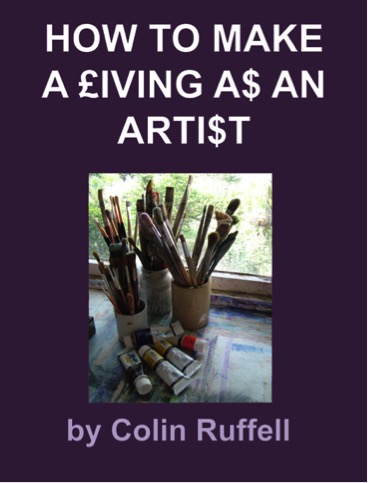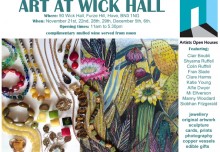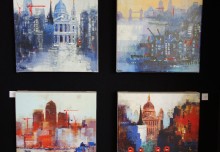Another interesting reminder of something that I wrote several years ago for ‘Art Business Today’ magazine. It was published in Jan 2011. We had just experienced the big financial crash. No-one knew what was going to happen next. I had recently published a book for professional artists. The magazine asked me to write an article aimed at the professional artist community.

‘How to Make a Living as an Artist’ by Colin Ruffell
Now, just six years later, it all seems much the same. Here is the article ….
Amateurs and professionals in the art business.
I have heard it estimated that there are 100 thousand artists in the UK. Most of them are happy amateurs while just a few hundred are full-time working professionals. An amateur artist is someone who enjoys making art, strives to make good art, and hopes that people recognize and appreciate his/her art. A professional artist is exactly the same, but with four big PLUS factors! Professional artists are also;
- 1. self -employed,
- 2. running a small-business,
- 3. competing in the fine art industry.
- 4. selling enough stuff to make a living.
It is blindingly obvious that many amateur, hobby, non-pro, artists do not have a monkeys snowball interest in self-employment, small business, or fine art trade competition. These subjects are taboo in some studios. Business is an anathema. Competition is a filthy concept. Trade is a swear word. ‘Surely’, they say to themselves and each other, ‘I want to paint pictures, and if I do good ones then the world will recognize this glorious fact and hail me as the genius that I am’.
I say to my fellow professionals, and all aspiring professionals, that such self-delusion is a good thing. Because the non-professional head-in-sand attitude means that there are only a handful of other artists competing with you in our shark infested industry, instead of 100,000.
I would love to indulge myself and write about the enjoying, striving, and hoping stuff. However, there are plenty of other places where readers can read about the amateur artist and his/her issues.
Instead I think it is my duty to talk here about the loneliness of self-employment, the difficulties of running oneself as a small-business, and the strength and weakness of competition within our industry.
Firstly, I have some good news. Please let me share with you the thing that boggles my mind and keeps me going most. Technology has changed everything!
Computers.
First came computers and Microsoft and Adobe providing cut and paste word processing with spell checks, the power and potential efficiency of spread sheets, and the wonderful Photoshop. Then along came small business accounting, Money, Sage, or similar programmes, and Powerpoint presentation. Business administration and efficiency was transformed.
Printing and Publishing.
For most of my long and illustrious professional art career [he says modestly] I have had to ‘paint pictures and sell them’. In fact that was the phrase I used to use to answer the inevitable question “So what do you do?”
But nowadays my answer is, ‘I paint pictures, publish prints, and sell them’. Not much different on the face of it, but very different in reality. And it is due to computers, inkjet printing, and the internet.
Only fifteen years ago, in the dim dark days before the cyber dawn and the inkjet print head, an artist who wanted to expand and leverage the efficiency and viability of his or her business by making prints had to use silk screen, etching, lino-cut, or engraving methods to create a time-consuming, hand-made, small-run of original prints.
Which is not very effective in leverage terms.
In theory you could use four colour lithography to make big runs of prints. The process involved monster Heidleberg high speed presses that cost an arm and a leg to set up and run. The print company probably wouldn’t wish to use heavyweight fine-art paper, and the inks used probably meant that the prints would fade in sunlight. Costs were very similar whether you had 10 or 1000, so you were tempted to choose 1000 so that the unit cost was affordable. The printer pressed the print button and a thousand prints were deposited into the tray in a few minutes. You had to publish the whole edition at once, without any variations, and even though each individual print was reasonably priced, you had to have, and pay for, all of them. Then you had to store them. You needed to win the pools, or inherit a fortune, or sell your children, to afford to amass and warehouse a portfolio collection of say just twenty images. That is 20,000 prints, to pay for, store safely, and sell. So most artists didn’t self publish. We left it to big business publishers.
It took those publishers a year or more to plan and execute a sales campaign for a new repro image, and it cost them a fortune to do it. Catalogues had to be printed, samples were put into portfolios and hawked around the galleries. They took big expensive space at trade fairs, in different countries, on different continents. Artists considered themselves very fortunate to be taken up by a publisher who would do this for them. Names like Frost and Reed and Soloman and Whitehead ruled the waves in the UK. Goodness knows the names of the big players in foreign markets, so goodness knows how an aspiring artist got in touch with the international market. But times have changed.
Inkjet printers.
Nowadays an artist can self publish and produce affordable high quality prints on demand. That fact alone deserves to command great awe and respect because it has changed everything.
An artist can now use the services of a print bureau and produce the first Artists Proof of an image for under £100. The minimum DIY set up includes a camera or scanner, plus an A3 fine art quality printer, and use of a computer with Photoshop or other image manipulation software. Your self-published multiple image portfolio can be produced for a few hundred pounds. Then you print only when you sell. No storage, no waste, high quality, speedy production, respectable profit margins. Magic.
Internet
The other thing that I mentioned was the internet or worldwide web. If anyone told you twenty years ago that you would be able to run an art gallery with the potential for 5 billion eyes to see your exhibits, change the stock in an instant, communicate with the whole world, find out about absolutely anything, send personal messages to thousands of people at once, almost for free, then you would have them banged up for lunacy or fraud. But it has actually happened. And it has happened in the last few years.
Now we are all used to these new features; U-tube, Facebook, blogging, Twitter, Google, i-phones, i-pad, Blackberry’s, Wacom tablets, digigraphs, cloud based computing, viral loops ….wowee! Whatever next?
Ye Gods, modern technology has handed us the keys to heaven.
Anyway, I think that you will agree that technology has changed everything, forever!
Oh! Maybe the value and purpose of art hasn’t changed, and hopefully the role of the artist to see, and express, and create, and inspire, and wonder, is the same. But now the aspiring professional artist can use these wondrous new technological tools to do it better.
Secondly, the environment is new. The gallery system is changing.
Outside London the UK art retail market has traditionally been a small-business cottage industry. Very few art galleries were more than a one man band. Some were very well run, and became established good local businesses. Many others were not, and so galleries came and went with monotony.
In recent years the high street has been affected and strongly influenced by super-efficient art publishers who have taken over many of the best galleries and established chains of in-house galleries. They also operate some exclusive gallery franchises, and they open new galleries where they see a good opportunity, usually in prime locations. These galleries might have a couple of token local artists, but by and large they look pretty much the same where-ever the gallery is throughout the UK. Same small band of artists, same expensive frames, same high-ticket prices, same marketing process, same charming sales patter. These publishers will have a contracted stable of artists getting the lion’s share of gallery sales. For the artists involved this offers someone else to do the selling, marketing, and administration, while you go away and paint, to order. You as an artist might get an offer to sell your soul to one of these mega gallery organizations in return for wealth and fame. Can you resist the temptation? Do you want to? It suits some artists very well.
Or you can be independent. Many professional artists will have to be. How do they do it then?
Selling direct to the art retail trade.
The traditional one-man-and-his-family galleries still exist even though their influence is no longer the paramount factor that it once was.
There are still some very well run, efficient, high quality, middle-art galleries specializing and selling original paintings and prints by professional artists. You can find quite a few of them on the Affordable Art Fair circuit. Go and visit the fairs to find these galleries. The art is good, un-controversial, and aimed mainly at the middle-class domestic market. The art buyers are from all age groups. The art quality and collector’s pleasure is genuine. The price ceiling for art at the Affordable is £4000. Many of the exhibits will sell for hundreds rather than thousands. However it is hard for an amateur artist to break into this market. The paintings have got to be good, but that is not enough. The artist has got to be proficient, reliable, and established. The galleries turn away dozens, maybe hundreds of hopefuls before they will back a new artist in this arena.
Slightly further down the street you can find retailers who sell reproduction prints as well as originals. They might be in secondary less expensive locations. The gallery will show some paintings and prints and can sell some for you as well. But this is probably not the gallery’s main source of income. They continue to survive because they are usually the best place for the public to go to for picture framing. They can do pretty well as framers especially if they are Fine Art Trade Guild qualified bespoke framers. Some small art galleries are also poster-art shops, gift shops, art materials shops, or maybe offer a print making service to artists. If a pro-artist can make contact with, and supply regular saleable product, and do business in a businesslike way, and satisfy several galleries at once, then the artist can still make a living.
Thirdly, there is the booming high-art at auction market dominated by Christies and Sothebys. This is where the nasty bankers have stashed all their plundered millions. This is where the emerging Chinese and Russian new-mega-rich, American super capitalists, and established oil sheiks, compete to spend their billions. As an artist my advice is…Forget it! Don’t even dream of getting into this market. If you are not there now, and are reading this, you have missed the boat like me. Sigh!
However, this super-booming fantastic market has attracted a lot of media attention. That same media focuses on the incredible prices and profits that some high-art dealers and collectors spend and make. This has the effect of stoking up ‘art acquisition desire’ in lesser mortals. All professional artists gain a little whenever Damien sells another diamond encrusted skull for more millions.
Fourthly. Selling to the consumer.
Artists can actually sell their art directly to collectors themselves in exciting new emerging markets.
This is how;
Have you noticed the growth of regional Art Fairs where artists or groups can exhibit, or fairs with an Artists Quarter, and Open Studios, and Artist’s Open House Art-trails. All these have become major factors in the life of a professional artist.
There is yet another major new outlet for you, ‘the online gallery’. Or your own website with a shopping cart facility.
Fifthly, another income stream is ‘licensing’ where the artist gets an income from other businesses when they use their images for greetings cards, post cards, posters, table mats, tee-shirts etc. This is part of the professional artist’s further business development programme where they should be trying to leverage their work and expertise. More about that in a moment.
Finally, these are exciting times, and exciting new ways and places where the professional artist can be in the art business.
You as an artist must realize that the art business is just that, in two words. Art and Business. The aspiring independent professional will have to become good at business. That involves investing money and time in ones business, and ones brand which is oneself. It also means finding out how to do things, seeking expert experienced help, joining in the industry, researching proven methods, and avoiding the common mistakes.
Readers may recall that I previously wrote, and gave a seminar last year at the 2010 Spring Fair, about the five skills that a pro-artist needs, and that he/she would only be as successful as their weakest skill. Briefly, 20% each of a pro-artists effort needs to be;
- 1. making art,
- 2. marketing and selling art,
- 3. administering a small business,
- 4. research and networking,
- 5. business development.
Now I am preparing a further seminar for the up-coming Spring Fair on ‘Business Development for Artists, especially Licensing’. Please come along and discuss this with me in February.
And keep it secret, between professional artists only. We don’t want to tell the other 100,000 artists that are out there.




